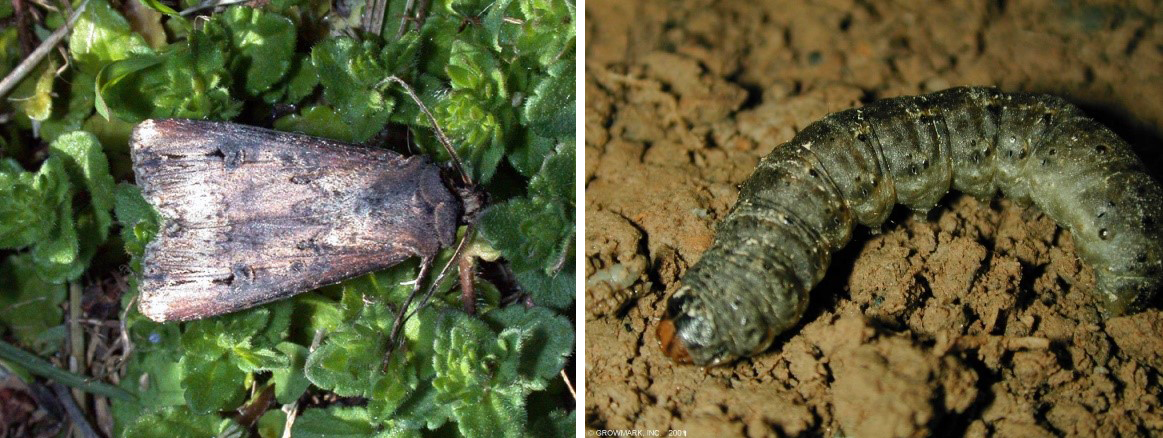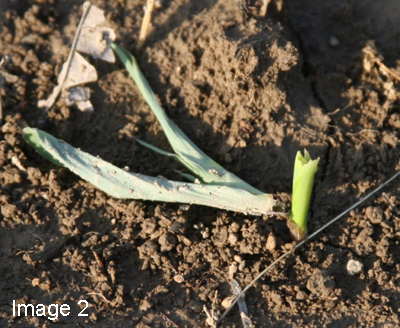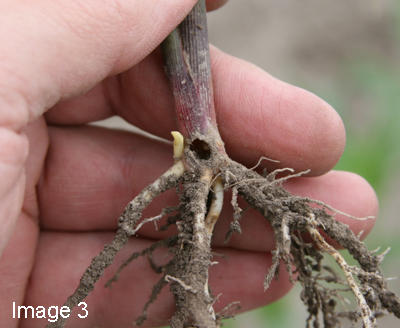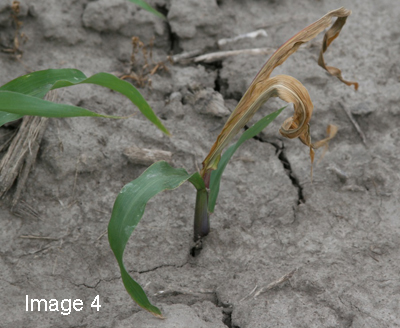
- Black cutworm larvae are a potentially serious threat to emerging corn.
- The risk of black cutworm damage increases in fields with winter annual weeds and minimum tillage.
- Bt traits are labeled for control but may not be highly effective in preventing stand loss.
- Preventive management may be warranted in high risk scenarios.
Pest status update as of 04-24-20: Significant black cutworm (BCW) moth flights have been reported in a few counties of Indiana. In Illinois and Iowa, a few BCW moths have been caught, but no significant flights have been recorded. As of April 25th, no trap reports are available for Wisconsin. Remember to scout your fields for signs of black cutworm feeding or cutting, from emergence through V5. Following these trapping updates is very important, as they provide some guidance on scouting activities based on degree days accumulated for this pest. How do we estimate the potential cutting date? The cutting damage to corn begins when 300 pest degree days have accumulated, following the first significant moth capture or biofix (9 or more moths caught over two consecutive nights). The degree days are calculated for a 24-hour period and accumulated (summed) over a period of time using the formula: [(maximum daily temperature + minimum daily temperature)/ 2] -50. This is how the projected cutting dates are calculated.
Biology and Life Cycle. Black cutworm moths generally do not overwinter in the Midwest, but instead migrate into the area in April and May on storm fronts and prevailing southwesterly winds. Adult moths are nocturnal, large bodied, and dark grey in color, with a black dagger-like marking on the outer forewing (Image 1). Females lay eggs near food sources such as grassy habitats, low areas of fields, soybean residues, and areas of winter annual weeds. Larvae hatch in 5-10 days after eggs are laid. The larvae molt through 7 instar stages over the course of about 28-35 days. Larvae are grey to black in color, about 1.5” long when mature, have a shiny or ‘greasy’ skin texture, and have paired tubercles (raised bumps) that are uneven in size on each body segment (Image 1).
Crop Injury. Early instar larvae migrate to corn after their initial food source is removed. Smaller larvae feed above ground on plant leaves, causing small irregular pin holes. When larvae reach 4th instar, they begin to cut plants and reduce stand (Image 2). Sometimes plants will be dragged under clods or into holes to continue feeding. Larvae may also bore a hole through the base of the stalk (Image 3). Plants may be cut underground and appear to be jabbed into the soil at an unusual angle or show ‘dead heart’ symptom (Image 4). Larvae move quickly up the row in search of more food. Each larva may cut up to 4 plants during its lifetime, so heavy infestations can damage large areas of fields very quickly. Corn is most susceptible from VE to V4 growth stages.
Scouting and Thresholds. Moth flights are monitored with pheromone traps and typically are reported weekly by land grant universities. Scout corn fields once per week for 3-4 weeks following emergence. Distribution may be patchy, so you should scout multiple locations and check 50 plants per location for evidence of feeding. Fields most at risk include those that were planted late and had weed infestations. Look for signs of leaf feeding, cutting, wilting, and missing plants. Leaf feeding by early instar larvae signals the need to scout again within 24-48 hours. Black cutworms are nocturnal feeders and retreat underground or hide beneath clods or residue during the daytime. They avoid dry or crusted surface soils and may retreat 3 or more inches below the soil surface to find moisture. Record the number of cut plants and the number and size of larvae found per 100 plants.
The risk of yield loss becomes less as the plants get larger, as the larvae approach maturity, and if surface soils are dry. During the leaf feeding stage, control may be warranted if 3-5% of plants show leaf feeding and 2 or more cutworms are present per 100 plants. As larvae get larger and begin to cut plants, a simple threshold of 3% cut plants and larvae still present and actively feeding may be used to trigger a rescue insecticide. The references below also provide dynamic thresholds and calculators based on larvae size, corn plant size, soil moisture, grain price, and insecticide price.
Management Recommendations. Preventive management can be very effective. Preventive measures include: controlling winter annual weed infestations, applying insecticides in-furrow at planting, applying broadcast insecticides with a pre-emergence herbicide, and using advanced Bt hybrids that feature either the Cry1F or the Vip3A traits. Several insecticide products can be applied preventively with a pre-emergence herbicide application, which manages the risk of not being able to apply a timely rescue due to inclement weather. One of the most cost-effective choices for residual preventive control is lambda-cyhalothrin. Several insecticides are labeled for broadcast rescue treatments. Talk to your FS Crop Specialist for scouting and control recommendations for black cutworm.
Always read and follow label directions.



Image 1. (Top) Black cutworm adult (left) and larvae (right). (Source: GROWMARK, Inc.)
Image 2. Corn plant cut by black cutworm (GROWMARK).
Image 3. Hole bored in base of stalk by black cutworm (GROWMARK).
Image 4. Corn ‘dead heart’ symptom caused by black cutworm feeding below ground (GROWMARK)
References:
Black Cutworm (University of Illinois)
Black Cutworm (Purdue University)
The Handy Bt Trait Table (2020 Update)